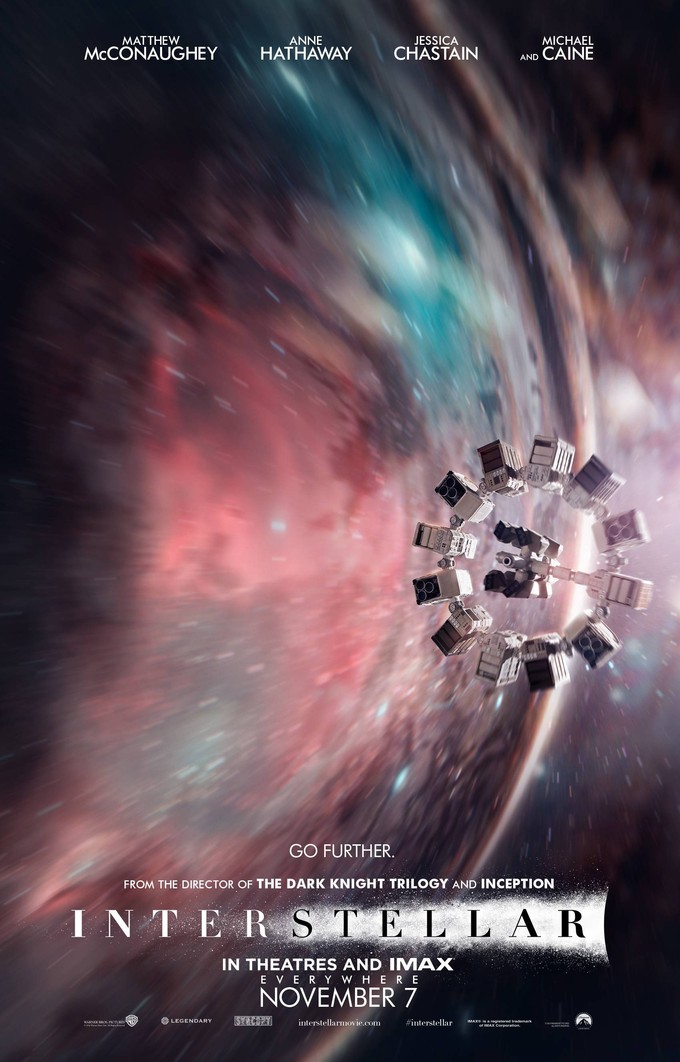
For months, people have been asking what I thought of INTERSTELLAR. I was lucky enough to catch one of the early IMAX screenings earlier this year, and soon after I promised to write up my thoughts. As I started doing some of the research and calculations, the scope of what I wanted to write grew to a daunting level, and then real-world astrophysics got in the way before I could finish. And many astrophysicists have shared their takes on it — you can find Neil deGrasse Tyson’s, for example, here (though I think he’s wrong about a few things). Phil Plait’s is on his Bad Astronomy blog at Slate here. But of course, the best is Kip Thorne’s book The Science of Interstellar. INTERSTELLAR was initially the brainchild of Kip Thorne and producer Linda Obst, and both are producers on the film. Thorne’s book is fascinating account of the history of the project, and just how much thought and scientific rigor went into the finished version. I highly recommend it no matter if you are a lover or hater of the film.
I haven’t seen anyone articulate my position on INTERSTELLAR exactly, so I thought I’d take the occasion of the DVD release to write up my thoughts. This got very long, so I’m splitting it into two parts. This article will cover mainly the science of the finished film. In part two, I’ll go into the history, earlier drafts, and the project it could have been.
MILLER TIME
One area they nailed in INTERSTELLAR is time dilation. That is, in relativity, time can move at different rates for two different observers. When you are moving close to the speed of light, or are experiencing very strong gravity, time moves slower for you than it does for a distant observer. This happens on Miller’s planet (the planet with the huge waves), because it is so close to the supermassive black hole (nicknamed Gargantua). In fact, this is the main reason Gargantua exists in the film — they wanted a device whereby one hour of time for the astronauts would equal seven years back on Earth.
In addition to an obstacle for the protagonists, this serves as a metaphor for parenthood — you blink your eye and your kids are grown up. In fact, in the original draft of the script, the time shifts are much more extreme. But the time lags in the film are about as far as you can push things with a supermassive black hole. It has to be spinning near the speed of light to achieve that effect.
The calculations it took to make this happen are no joke. Right after INTERSTELLAR came out, some astronomers said that the orbit of the planet with time dilation could not exist. However, they had assumed a stationary black hole and not taken into account the much more difficult calculation of a rapidly rotating black hole. Kip Thorne, of course, was way ahead of them, and had done the calculations correctly.
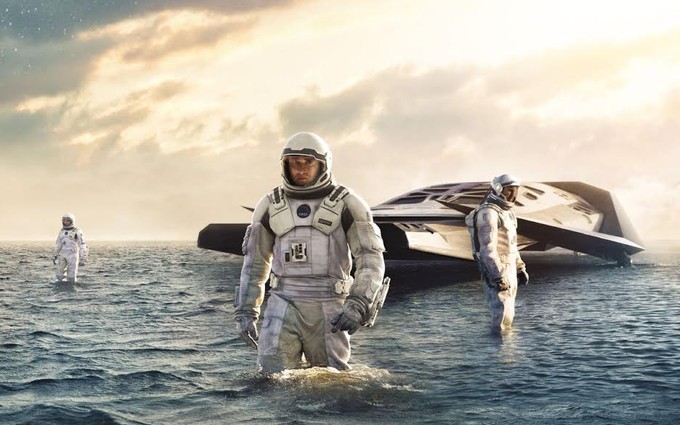
Even more impressive than the fact that he calculated that the planet could exist is that the visualization of the black hole is also based on real physics! This WIRED article and video explains how they had two dozen people working on the most realistic-ever simulation of a black hole. The result is one of the most beautiful and majestic things I have ever seen, particularly when you see it in its full IMAX splendor. They even got some scientific papers out of it. I see astrophysical simulations all the time. But to throw big-budget Hollywood money at one? This is what our society should be doing with our largesse!
The treatment of Gargantua is INTERSTELLAR at its most sublime. Hollywood and academia coming together at the top levels to push movies and physics to the extreme. Great minds, huge budgets, spectacle aplenty, and thought provoking scenes we’ve never seen in film before.
Needing this much time dilation, and deciding to justify it realistically, does introduce a whole boatload of crazy follow-on effects though. Thorne calculated that Miller’s planet would need to be orbiting the black hole at ten times per second! At least, that’s what you’d see as an outside observer. You need to be moving close to the speed of light to reach such a planet, and this has extreme consequences, as we’ll see later. I’ve got no problem with being this bold, as long as you follow through with the consequences.
A STAR IS TORN
While I’m on the subject of Gargantua, many people have been upset that there is no star in any of the planetary systems in the film. The idea here is that the accretion disk — that disk of material circling the giant black hole, is about the same temperature as a star. So in effect, the disk is a flat star.
According to the calculations in Kip Thorne’s book, Miller’s planet was so close that the black hole would actually take up half the sky. That would have made an incredible scene! But Christopher Nolan had them shrink it way down, because he didn’t want close-ups of the black hole until the climax.
The large apparent size of Gargantua (i.e. the size it was supposed to have been) is partly due to the bending of light by the black hole, but was also because it was physically so close. A star spread out over such a large area would have really fried the planet if the disk were the same temperature as our star. That’s because the amount of energy you get depends on both the temperature and the surface area of the radiating body. So the accretion disk would have to be much cooler than the sun. I’m not quite sure you could make it work. Christopher Nolan changing the size actually helped in that respect. But at the same time, that ruins the beautiful time dilation calculations.
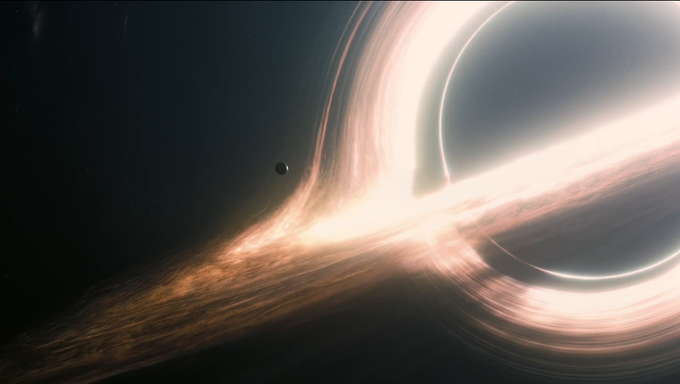
Any matter in an accretion disk orbiting close to a black hole gets whipped up to incredible speeds. Friction gives it insane energies, causing it to emit x-rays and sometimes gamma-rays. These would fry any life in the vicinity. Almost all accretion disks we see at the hearts of galaxies act like this. To get around this, Kip Thorne had to make the accretion disk a very weak one, with no material close to the black hole. But disks don’t exist in that state for long. Ultimately, when gas flows into the system (these black holes are constantly feeding on gas), or a star gets ripped apart (this happens — I’ve observed in with my own telescopes!), that black hole and disk are going to flare up and kill everyone.
I suppose you could argue that humanity was desperate, so they only needed to find a temporary home, maybe for a few hundred years. Still, living near a supermassive black hole is one of the worst neighborhoods, astrophysically speaking, one could look for a home in.
WE ARE FARMERS
When the US was founded, 90% of the population of 4 million people were farmers.
Today, less than 1% of the 313 million people in the US call farming their profession. Imagine that! In absolute terms we have fewer farmers today than 200 years ago, but we can feed more than 300 million more people. It is actually even crazier than that, since today the US is a net exporter of food. Our per-farmer efficiency has grown by about a factor of 100! This is due to many factors like the industrial revolution and dramatic increases in our scientific understanding. But it is also largely because of economies of scale. It is more efficient if one farmer can harvest 100 acres using one piece of machinery than to have 100 farmers tending an acre each.
That’s one reason some of the early plot points about the blight fall flat to me. The default career path for students in the future seems to be that they have to become farmers, unless they are brilliant. Technology has fallen by the wayside, and humanity is forced to scrounge drones for the spare parts to use in harvesters. This doesn’t make much sense. In today’s world, the number of able-bodied humans involved is not the limiting factor in crop yield. And investments in technology pay dividends in crop yields.
I do appreciate the conceit that blight has ruined the world’s crops and changed the game. Maybe large-scale farming and its monocultures made us more susceptible to this. But that isn’t what they signal in the film, since corn is the only thing left. I suppose you could also argue that blight has made farm profitability abysmal. But supply and demand should take care of the profitability of farming. There are ways of writing an ecological catastrophe that are plausible, and a ton of thought was actually put into this by a big team of scientists. Kip Thorne mentions that they had a team of some of the world’s leading biologists and thinkers to brainstorm ideas, way back at the initial conception of the script. It is a shame that many of those profound ideas never made it to the screen.
BIZARRO NASA
I found it beyond silly that NASA was holed up in a secret base. NASA has always represented hope. If there is even a chance that they are humanity’s salvation, then it does you well to advertise that fact. But beyond the palliative need, there is a functional one — how are you going to inspire the next generation of geniuses to pursue math, physics, and engineering, if they think there is no application for their talents? This isn’t just an academic argument — the stakes are life and death for the whole species. They even threw in an unearned line about how it is now the official educational position that NASA never went to the moon. Sometimes filmmakers take the idea of a narrative arc to a ridiculous extreme. If NASA is going to save the day in the end, it doesn’t have to start off as an underdog.
If that’s all that was wrong, it would be no big deal. But this NASA is idiotic to the extreme. They are launching Apollo-sized rockets from underground, which would really exacerbate the already-significant problems caused by heat, sound, and exhaust products. One bad break means you destroy your rocket building facility *and* needlessly expensive tunneled-out launch facility. Then, for the trifecta, they seem to have their offices *right there in the rocket silo,* ensuring that in a disaster all of NASA is also wiped out. In fact, the Soviet Union had one such disaster in 1960, though it was covered up until 1989. They learned the lesson the hard way. Don’t have your top rocket people anywhere near the launch pad during a launch. Modern NASA knows this — you can’t get closer than 3 miles from a launch. Trust me, as a kid growing up in Florida, I tried!
INTERSTELLAR’s NASA seems to only have a handful of people, as opposed to the estimated 400,000 employees of the Apollo program at its peak (just let that soak in for a second). Their astronaut selection skills involve nepotism, picking astronauts who are romantically conflicted, robots with less dexterity than those currently on the space station, and humans who have the kind of psychotic breaks that would make a xenomorph seem friendly. And their best recruit is a guy who literally wanders in off the street, has no idea the program even exists, and who they don’t have time to train.
Everything about this version of NASA seems contrived, and ill-contrived at that — nothing about it seems organic. But maybe this is what NASA is like after people like Ted Cruz are in charge for decades— it has been cut down to a skeleton crew of half-wits.
THE ONE BAUD MODEM
This version of NASA also can’t figure out how to get more than one bit of information from each of the probes they sent out. The probes either seem to say, “Come to the planet,” or “Don’t come.” This is idiotic, and there is no justification for it, except that the Nolans felt they needed to write it that way for maximum drama. The modem on my Commodore64 was better. We can communicate better with our probes that are already either out of the solar system or on their way out, and those were built with 60s and 70s technology. And if you can drive a spaceship full of people there, you can certainly send a message. It is orders and orders of magnitude easier.
Now you may say, well they needed that bit of artistic license to tell the story. Actually, they didn’t. The first draft of the script is much smarter, and didn’t need to stretch reality past the breaking point to amp up the drama. But more about that in Part 2.
TO INFINITY… AND BEYOND
Rather than launch straight from Earth to Jupiter, which would be impossible for their mission profile, they do the very sensible thing, and transfer spacecraft once in Earth orbit. There they dock with their waiting interplanetary (actually intergalactic) ship, the Endurance, which has been launched in pieces and assembled by robots.
Since it takes a lot of fuel to overcome the gravitational potential of the Earth, they do what every manned mission has done, and use a multistage vehicle. Most of what you are carrying is fuel, so it makes sense to ditch pieces of your spacecraft once they are empty, thereby lightening the load. This even becomes a major plot point towards the end of the film.
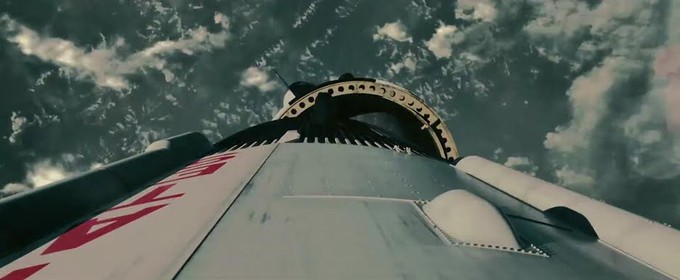
That’s all great, except that for the entire middle of the film they ignore this. At some point they say that Miller’s planet, has 1.3 times Earth’s gravity. That means that it would take an even bigger multi-stage rocket than it took to launch from Earth to get off the surface. Yet they just use their little single-stage Ranger spacecraft to blast off again.
I understand why Nolan did this. He wanted to invoke the pride and wonder of the Apollo program in the Earth-based launch sequence. And yet they couldn’t repeat that on the planet, because obviously there was no infrastructure there. Well guess what, that means you don’t get to have the whole Apollo launch sequence in the first place! Sometimes movies have to make compromises on cool things for the sake of passing the laugh test. It would have been fine for the whole film to have just started out with advanced single-stage to orbit vehicles. But once you establish something else, you need to have internal consistency.
Sadly, it gets worse from there. To land on Miller’s planet requires many orbital transfers, necessitating huge changes in velocity, requiring huge amounts of energy. There are a bunch of glorious calculations about this, with orbits drawn(!) in Kip Thorne’s book. As I mentioned before, sometimes the ship has to be going as fast as half the speed of light! To achieve this, Thorne imagines using intermediate mass black holes (that is, those with masses between a few solar masses and millions of solar masses) as gravitational slingshots. The problem is that it requires many black holes in the system, and they have to be arranged at the right orbits and arrive at the right time. Even if such black holes existed, the crew would have to wait many months or years for them to be in the right configuration to do a given maneuver.
But in the final version of the film, they rocket wherever the hell they want to go, and they visit multiple planets. They give a nod to having to slingshot, but they get the details wrong, claiming they are going to zip around a neutron star. You’d have to get so close to a neutron star to do this that the tidal forcers would actually rip you apart.
Kip Thorne is such a badass that he actually calculated out the slingshots, and even visualized what the black hole would look like during one (it is very cool — see his book; sadly it was not used in the film). He told Christopher Nolan that it would be wrong to do it with neutron stars, but Nolan thought that audiences would be too confused if there was more than one black hole in the film. That kind of arrogance bugs me so much — to deliberately do things the wrong way, just because you think the audience is too stupid to understand if you do it right.
And again, if you need a magic spaceship to tell your story, that’s fine. But write it that way. Don’t build into the drama that you implausibly need to dump a stage and leave two characters behind in the climax when you’ve been ignoring physics and fuel the entire film. And as-written, those characters’ sacrifices would have done next to nothing — they would barely have changed the orbit of the ship at all. To have exquisite calculations done and only abide by them when it is convenient is maddening. It ruins the point of doing it in the first place.
WAVING GOODBYE
As I mentioned, when the astronauts visit Miller’s planet, they are confronted with gravity 1.3 times that of Earth. I do like that. In virtually every planet in science fiction, gravity is 1g — the same as Earth. But the big surprise on this planet is huge tidal waves.
The tidal waves did look cool, but scientifically, they are a stretch. Tides happen on Earth because the sun and/or moon pulls the water closest to the moon or sun out a little more than the land, and doesn’t pull the water on the opposite side as much, resulting in two “tidal bulges.” As the Earth rotates under this bulge, we experiences high and low tides.
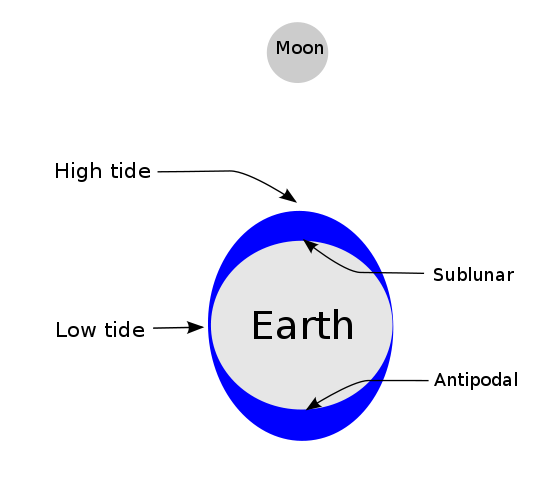
What if we were really close to a supermassive black hole instead of the moon? I’m sure the filmmakers followed the above logic and thought: we’d get really huge tides! But it doesn’t work that way. When tidal forces are large, you get what is called tidal locking. This is what has happened with our moon, and most moons close to their planets in the solar system. The moon always presents the same face to the Earth. As the moon orbits the Earth in about a month, it spins exactly once on its axis. Thus the lunar “day” is equal to the lunar “year” (about what we call a month, which is derive from “moon”).
When you have tidal locking, you don’t get the planet rotating under the tidal bulges. So the result is no tidal waves — just really deep oceans in some parts of the planet, and shallow ones other places. Kip Thorne did the calculation, and yes, Miller’s planet had to be tidally locked. So he had to posit some kind of imperfect tidal locking to get the ocean to slosh back and forth. Either that or there are constant earthquakes on the planet causing tsunamis. Neither are very satisfying, but they aren’t strictly speaking ruled out.
So this isn’t a show-stopper but it just rubs me the wrong way. It makes it so that the more you know about astronomy, the less you like the movie, because it runs counter to how tides actually work. It seems like something a screenwriter threw in because he thought it was “cool,” but makes little actual sense. Indeed, that’s what happened — this wasn’t Thorne’s idea and he had to stretch for a justification after the fact. That is getting away from the initial spirit of INTERSTELLAR, for the plot to stem from scientific understanding.
But there’s another reason I don’t like it. It is easy to calculate whether a planet would be tidally locked — I remember doing this calculation as an undergraduate student. And whether through calculation or observation, the crew should have known there would be killer tidal waves before setting foot on the planet. Remember, this planet is so close to the black hole that it orbits the black hole ten times per second! It would be insanely difficult to get to such a planet even once in a ship, let alone many times with all of humanity in tow. And the time dilation is a bitch! Everything about this planet screams that this is a bad choice.
I SURVIVED A BLACK HOLE AND ALL I GOT WAS THIS T-SHIRT
We all know that as you fall into a black hole you get ripped apart from the immense gravity, right? Not exactly. You could replace the Earth with a black hole with the mass of the Earth, and the moon would continue to orbit it happily (and yes, in principle you can have black holes the size of the Earth). In actuality, black holes can rip you apart not because they are high mass, but because you can get much closer to that mass.
That’s because what rips you apart is tidal forces. Tidal forces are just the difference between the forces at two points. Tides in oceans arise because there is a difference in the gravitational attraction on the side of the Earth closest to the moon, and the point opposite the moon.
Tidal forces are just the derivative of Newton’s law of gravitation: F=2GMmd/r3, where G is the gravitational constant, M is the mass of the parent body causing the tides, m is the mass of the object with tides, d distance over which tidal forces are being calculated (say, the diameter of the Earth in the above example), and r is the distance to the parent body. Notice that unlike the gravitational force, which diminishes as the square of the distance from something, the tidal force drops off as the cube of the distance. Conversely, if you get close to something, the tidal forces become huge. And in a black hole, that’s where the magic happens.
Strangely enough, if you do the math, you can see that supermassive black holes have *much* lower tidal forces than smaller black holes, by factors of billions and billions! So you actually could survive falling into a supermassive black hole. At least, you could cross the event horizon (the point of no return) without being torn apart. Once you are in there, you’d be killed as you got closer to the singularity. But the main idea is that in a supermassive black hole you could at least cross the event horizon intact, whereas in a stellar mass black hole you’d be ripped apart before you even got close.
For a long time, physicists have argued that you wouldn’t notice anything special as you cross the event horizon. But that may not be true — there could be a “firewall” that would burn you up before you enter, according to some of my colleagues at UCSB. This is a huge debate currently raging about this among black hole physicists.
What happens once you are inside the black hole? We don’t know, because you can’t communicate from inside one, and you can’t escape. In the movie though, Cooper is magically rescued by some advanced civilization. I don’t mind the idea that an advanced civilization can somehow survive a black hole. But to have that as a solution to a seemingly inescapable trap is just bad writing. It is a deus ex machina of the highest order.
THE TESSERACT, LESSER ACT
Cooper magically is rescued from the black hole into something they call the tesseract. As a cube is to a square, the tesseract is to the cube. It is kind of a 4d cube. That’s a fitting name for something that allows you to access more dimensions than our three spacial and one time dimension.

This was apparently constructed by the bulk beings (aka fifth dimensional beings) to allow Cooper to communicate with Murph. It gives a visual representation to the multiple dimensions — he can access any point in Murph’s timeline from the tesseract. But apparently, only gravity can communicate backwards in time. The bulk beings have set things up so that when Cooper interacts with the tesseract, he can send little gravity pulses back in time. Well, kind of. Apparently photons from the past can show up in the tesseract (i.e. he can see the past), but they can’t send photons from the tesseract into the past. And these super-advanced beings somehow can’t locate Murph in the past to do all this themselves, because they need Cooper as some kind of magic love bridge.
This is mentioned a few times in the film, that somehow love transcends space and time and is kind of like another dimension unto itself. Ugh. I really hate all that maudlin nonsense. For emotion to have any weight, as a filmmaker you have to make the audience *feel* it. Just telling us about it is why the Anakin - Padme love story is laugh-out-loud bad.
The tesseract is a neat idea though. If you are in a hyperdimensional space, the idea of accessing time nonlinearly is not crazy. And visually, the tesseract is amazing. They went to great lengths to make that visual representation make logical sense. The way he accesses time through it is very cool — it is worth watching the tesseract scenes a few times because they put a ton of thought into it. It isn’t random scenes you are seeing all around it. It is way too complicated to explain here, but Kip Thorne does a great job of it in his book.
I’m not a huge fan of using gravity pulses to tick a wristwatch hand to send an equation via morse code. I understand the symbolism (it is a watch, he’s manipulating time, it is a symbol of their love, I get it), but it just comes across as overly contrived to me. You build this hyper-advanced transdimensional time machine and all you can muster is Morse code on a watch?
I’m also not a fan of the conceit that you can just observe a singularity and magically know how to solve equations with it. Nor with the idea that solving some equation means you can now easily overcome Earth’s gravity. All of this is just a shorthand for science, and I do get that: we make observations in new realms, come up with new theories, and make new capabilities that one day must have seemed like magic. I don’t have a problem with the idea of having humans learning how to manipulate gravity (maybe by understanding gravitons), but to have it come by solving some equation is just silly. That’s how people who don’t know anything about science think science works.
THAT’S NO MOON, IT’S A…
After the bulk beings are done with you, they do the equivalent of dumping you into a ditch alongside the New Jersey turnpike in BEING JOHN MALKOVICH. Only here they leave you floating in space near Saturn. Once Cooper is rescued, he wakes up in a space station.
These space stations are kind of the opposite of Death Stars in that they save humans from a dead planet instead of incinerating a healthy one. I guess they are Life Stars!
This is my biggest single gripe about the science in INTERSTELLAR, because it reveals that the entire plot of the film is pointless. They solved the blight problem because they are able to grow crops in the space station that are separated from those on Earth. But why not just grow them in a hermetically sealed biosphere on Earth? There is *no reason* to launch that biosphere into space. In fact, there are a million reasons not to — it is much more expensive, more dangerous, smaller, and requires all kinds of new technologies. If humanity can be saved by a biosphere, there’s no reason to solve the gravity equation, and there is no reason to go to such extreme lengths to go through the wormhole.
SO WHAT DID I THINK?
I loved some aspects of INTERSTELLAR, but overall I found it to be supremely disappointing. It tried to cram too many plot points together, and didn’t give us enough time to appreciate the awe and wonder of what they were doing. It felt like a Frankenstein monster of a film, stitched together from different parts with different sensibilities. Part unbelievable realism, but part ridiculousness. Part hardcore logic, part over-sentimentalized silliness. Part thought-provoking scifi, and part conventional action film. The film felt that way because it really was a shotgun marriage between very different points of view once Christopher Nolan came on board. The first draft of the script, from 2008, is quite different, and has almost none of the elements that gave me problems.
More on that in Part 2!
- Copernicus (aka Andy Howell). Email me or follow me on Twitter.
